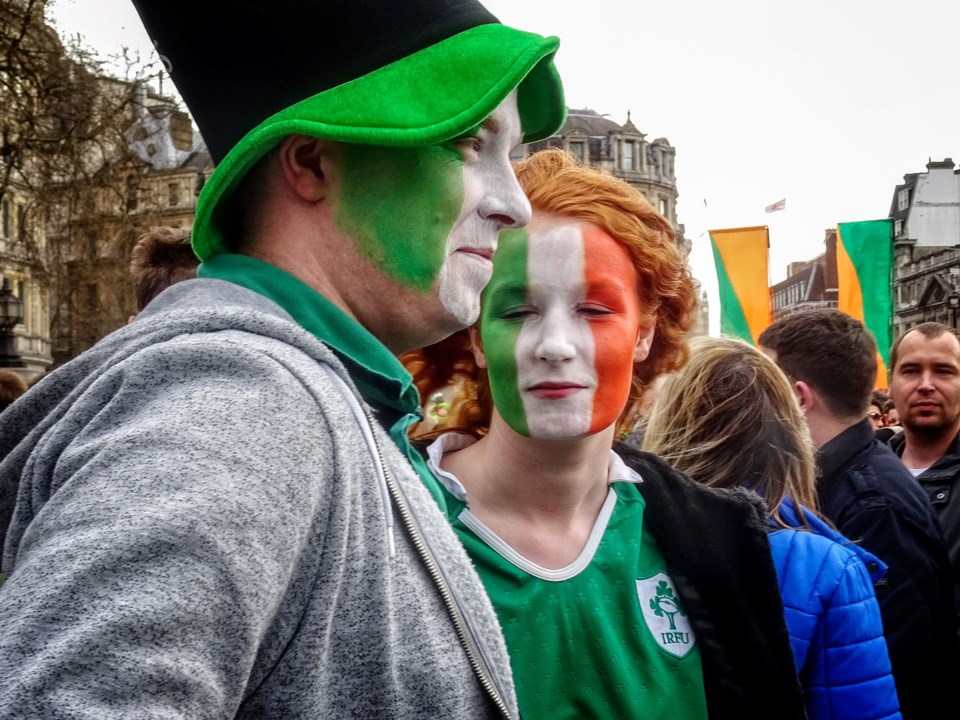 Lá Fhéile Pádraig Shona. Or maybe you prefer the more Anglicized greeting, “Happy St. Patrick’s Day”? The first sentence is in Irish, but we’ll go with the second version of the greeting. Tomorrow is indeed Saint Patrick’s Day and it will be marked by all sorts of people who would normally not bother honouring saints. March 17 represents the date when Patrick died in 461 CE. Today he is regarded as the patron saint of Ireland. Patrick’s holy status comes from his being associated with the Christianizing of that country.
Lá Fhéile Pádraig Shona. Or maybe you prefer the more Anglicized greeting, “Happy St. Patrick’s Day”? The first sentence is in Irish, but we’ll go with the second version of the greeting. Tomorrow is indeed Saint Patrick’s Day and it will be marked by all sorts of people who would normally not bother honouring saints. March 17 represents the date when Patrick died in 461 CE. Today he is regarded as the patron saint of Ireland. Patrick’s holy status comes from his being associated with the Christianizing of that country.
St. Patrick’s Day in Canada is not an official government holiday in the way that a couple of other religious days have been given statutory recognition – Christmas Day and Good Friday. (Federally regulated employees also get Easter Monday off.) In Ireland,  St. Patrick’s Day is a national holiday. And on this side of the Atlantic, people of Irish descent and people who just like the colour green, are keen to display leprechauns, shamrocks, golden harps and green beer.  Chicago has been dying the Chicago River green on St. Patrick’s Day, since 1962.  Montreal, Boston and New York have long established St. Patrick’s Day parades. What is known as a saint’s day is largely a celebration of idealized Irish culture.Â
How we deal with public religious observances in a secular society is sometimes the cause of considerable debate. No one seems to take umbrage at St. Patrick’s Day, perhaps because any religious significance has been largely eclipsed by a celebration of Irish folklore, rather than devotion to a religious saint. Who’s against being Irish, if only for a day? But when the same discussion about separation of church and state is brought up about Christmas and Easter, the tone is rather different. Should the City of Victoria put up Christmas decorations and turn the Sequoia in Centennial Square into a Christmas Tree, using public money?  Should Easter egg hunts be allowed in public parks, when only part of the population celebrates Easter?  Should there be a pubic menorah lit at Chanukah?
The core spiritual issue in such matters revolves around one’s understanding of what it means to be a secular society. Following the French Revolution in 1789, all expressions of religion in the public space were forbidden. This understanding of the secular is called “closed secularism”, in that society is closed to religious expression on the basis of separation of church and state. This French understanding carries on in Quebec today, where there has been controversy about public servants being banned from wearing obvious religious symbols. A second tradition of “secular” means that the state is neutral towards religious affiliation, while observing separation of church and state. In principle, a variety of religious expressions could happen in public space as long as all religions are treated equally.  This second model is sometimes called “open secularism” and it’s the model envisioned in the Canadian Charter of Rights and Freedoms. Many religions exist in Canadian society, so practising toleration and treating them equally requires some juggling and negotiation.
A further complication is that holidays like Christmas and Easter have dimensions that are not religious and these social customs exist independently of any religious affiliation – e.g. putting up lights in the dark of winter, giving presents to loved ones, having parties, sending children out to gather eggs hidden by Easter bunnies.  People are free to cherry pick what parts of holidays they will participate in, or not. And you don’t have to be saintly or even Irish, to enjoy St. Patrick’s Day. Happy picking!
 Larry Scott, a retired United Church minister.
Larry Scott, a retired United Church minister.
You can read more articles on our interfiath blog, Spiritually SPeaking,
* This article was published in the prinyt edition of the tImes Colonist on Saturday, March 16th 2019
St Patrick's Day photo: Garry Knight from London, England [CC BY 2.0 (]


